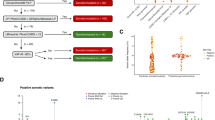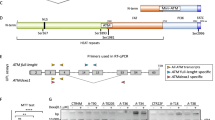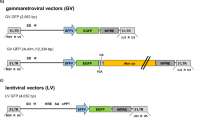Abstract
Ataxia-telangiectasia (A-T) is a recessive multi-system disorder caused by mutations in the ATM gene1,2 at 11q22–q23 (ref. 3). The risk of cancer, especially lymphoid neoplasias, is substantially elevated in A-T patients4 and has long been associated with chromosomal instability5. By analysing tumour DNA from patients with sporadic T-cell prolymphocytic leukaemia (T-PLL), a rare clonal malignancy with similarities to a mature T-cell leukaemia seen in A-T6,7, we demonstrate a high frequency of ATM mutations in T-PLL In marked contrast to the ATM mutation pattern in A-T, the most frequent nucleotide changes in this leukaemia were missense mutations. These clustered in the region corresponding to the kinase domain, which is highly conserved in ATM-related proteins in mouse, yeast and Drosophila. The resulting amino-acid substitutions are predicted to interfere with ATP binding or substrate recognition. Two of seventeen mutated T-PLL samples had a previously reported A-T allele. In contrast, no mutations were detected in the p53 gene, suggesting that this tumour suppressor is not frequently altered in this leukaemia. Occasional missense mutations in ATM were also found in tumour DNA from patients with B-cell non-Hodgkin's lymphomas (B-NHL) and a B-NHL cell line. The evidence of a significant proportion of loss-of-function mutations and a complete absence of the normal copy of ATM in the majority of mutated tumours establishes somatic inactivation of this gene in the pathogenesis of sporadic T-PLL and suggests that ATM acts as a tumour suppressor. As constitutional DNA was not available, a putative hereditary predisposition to T-PLL will require further investigation.
This is a preview of subscription content, access via your institution
Access options
Subscribe to this journal
Receive 12 print issues and online access
$259.00 per year
only $21.58 per issue
Buy this article
- Purchase on SpringerLink
- Instant access to full article PDF
Prices may be subject to local taxes which are calculated during checkout
Similar content being viewed by others
References
Savitsky, K. et al. A single ataxia telangiectasia gene with a product similar to PI-3 kinase. Science 268, 1749–1753 (1995).
Savitsky, K. et al. The complete sequence of the coding region of the ATM gene reveals similarity to cell cycle regulators in different species. Hum. Mol. Genet. 4, 2025–2032 (1995).
Gatti, R.A. et al. Localization of an ataxia-telangiectasia gene to chromosome 11q22–23. Nature 336, 577–580 (1988).
Taylor, A.M.R., Metcalfe, J.A., Thick, J. & Mak, Y.-F. Leukemia and lymphoma in ataxia telangiectasia. Blood B7, 423–438 (1996).
Hecht, R., et al. Leukaemia and lymphocytes in ataxia-telangiectasia. Lancet 2, 1193 (1966).
Galton, D.A.G. et al. Prolymphocytic leukaemia. Br. J. Haematol. 27, 7–23 (1974).
Brito-Babapulle, V. & Catovsky, D. Inversions and tandem translocations involving chromosome 14q11 and 14q32 in T-cell prolymphocytic leukemia and T-cell leukemias in patients with ataxia-telangiectasia. Cancer Genet Cytogenet. 55, 1–9 (1991).
Matutes, E. et al. Clinical and laboratory features of 78 cases of T-prolymphocytic leukemia. Blood 78, 3269–3274 (1991).
Taylor, A.M.R. & Butterworth, S.V. Clonal evolution of T-cell chronic lymphocytic leukaemia in a patient with ataxia telangiectasia. Int. J. Cancer 37, 511–516 (1986).
Russo, G. et al. Molecular analysis of a t(14;14) translocation in leukemic T-cell of an ataxia telangiectasia patient. Proc. Natl. Acad. Sci. USA 86, 602–606 (1989).
Voˇechovstý, I. et al. The ATM gene and susceptibility to breast cancer: analysis of 38 breast tumours reveals no evidence for mutation. Cancer Res. 56, 2726–2732 (1996).
Vořechovský, I. et al. Exon-scanning mutation analysis of the ATM gene in patients with ataxia-telangiectasia. Eur. J. Hum. Genet. 4, 352–355 (1996).
Gilad, S. et al. Predominance of null mutations in ataxia-telangiectasia. Hum. Mol. Genet. 5, 433–439 (1996).
Byrd, P. et al. Mutations revealed by sequencing the 5′ half of the gene for ataxia telangiectasia. Hum. Mol. Genet. 5, 145–149 (1996).
Telatar, M. et al. Ataxia-telangiectasia: mutations in ATM cDNA detected by protein-truncation screening. Am. J. Hum. Genet. 59, 40–44 (1996).
Wright, J. et al. A high frequency of distinct ATM gene mutations in ataxia-telangiectasia. Am. J. Hum. Genet. 59, 839–846 (1996).
Baumer, A., Bernthaler, U., Wolz, W., Hoehn, H. & Schindler, D. New mutations in the ataxia-telangiectasia gene. Hum. Genet. 98, 246–249 (1996).
Zech, L., Hammarström, L. & Smith, C.I.E. Chromosomal aberrations in a case of T-cell CLL with concomitant IgA myeloma. Int. J. Cancer 32, 431–435 (1983).
Zakian, V.A. ATM-related genes: what do they tell us about functions of the human gene? Cell 82, 685–687 (1995).
Lakin, N.D. et al. Analysis of the ATM protein in wild-type and ataxia telangiectasia cells. Oncogene 13, 2707–2716 (1996).
McConville, C.M. et al. Mutations associated with variant phenotypes in ataxia-telangiectasia. Am. J. Hum. Genet. 59, 320–330 (1996).
Shafman, T. et al. Interaction between ATM protein and c-Abl in response to DNA damage. Nature 387, 520–523 (1997).
Easton, D.F. Cancer risk in A-T heterozygotes. Int. J. Radiat. Biol. 66, S177–S182 (1994).
Swift, M., Morrell, D., Massey, R.B. & Chase, C.L. Incidence of cancer in 161 families affected by ataxia telangiectasia. N. Engl. J. Med. 325, 1831–1836 (1991).
Hartwell, L.H. & Kastan, M.B. Cell cycle control and cancer. Science 266, 1821–1828 (1994).
Jadayel, D.M. et al. Potential role for concurrent abnormalities of the cyclin D1, p16cbKN2 and pl5CDKW2B genes jn certain B cell non-Hodgkin's lymphomas: functional studies in a cell line (Granta 519). Leukemia 11, 64–72 (1997).
Barlow, C. et al. Atm-deficient mice: a paradigm of ataxia telangiectasia. Cell 86, 159–171 (1996).
Xu, Y. & Baltimore, D. Dual roles of ATM in the cellular response to radiation and in cell growth control. Genes Dev. 10, 2401–2410 (1996).
Knudson, A.G. Mutation and cancer: statistical study of retinoblastoma. Proc Natl. Acad. Sci. USA 68, 820–823 (1971).
Voˇechovský et al. ATM mutations in cancer families. Cancer Res. 56, 4130–4133 (1996).
Author information
Authors and Affiliations
Rights and permissions
About this article
Cite this article
Vořechovský, I., Luo, L., Dyer, M. et al. Clustering of missense mutations in the ataxia-telanglectasia gene in a sporadic T-cell leukaemia. Nat Genet 17, 96–99 (1997). https://doi.org/10.1038/ng0997-96
Received:
Accepted:
Issue date:
DOI: https://doi.org/10.1038/ng0997-96
This article is cited by
-
Germline CHEK2 and ATM Variants in Myeloid and Other Hematopoietic Malignancies
Current Hematologic Malignancy Reports (2022)
-
Self-inflicted DNA double-strand breaks sustain tumorigenicity and stemness of cancer cells
Cell Research (2017)
-
A multiplex preclinical model for adenoid cystic carcinoma of the salivary gland identifies regorafenib as a potential therapeutic drug
Scientific Reports (2017)
-
DNA damage response and hematological malignancy
International Journal of Hematology (2017)
-
The dual-acting chemotherapeutic agent Alchemix induces cell death independently of ATM and p53
Oncogene (2015)



